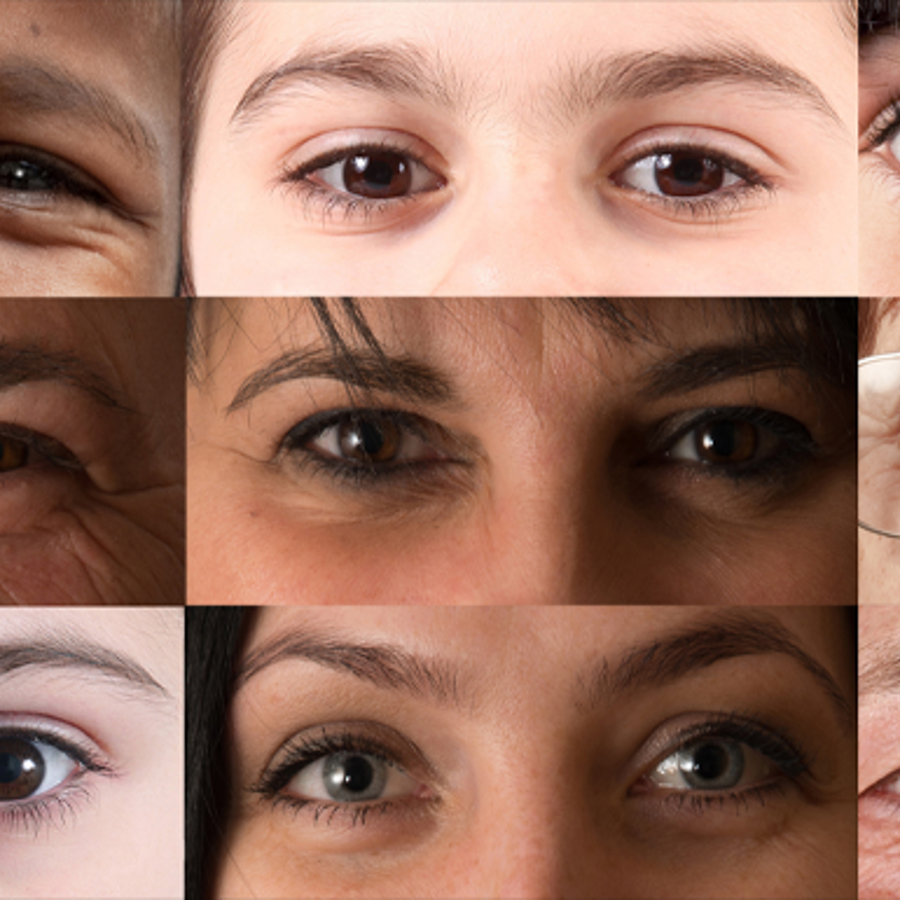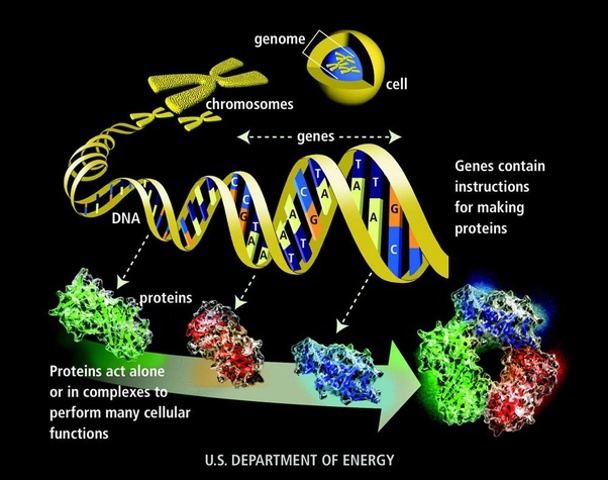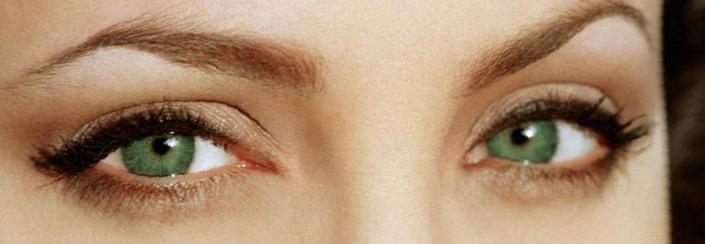
How do different shades of eye color happen? Like light or dark brown?
September 23, 2010

- Related Topics:
- Eye color,
- Pigmentation traits,
- Complex traits,
- Genes to proteins
A curious adult from California asks:
"How do different shades of eye color happen? Like light or dark brown?"
This is a very interesting question! We know the what of your question but the why is still fuzzy.
Eye color is the result of variations in the amount of melanin, a pigment found in the front part of the iris of the eye. The lack of this pigment results in blue eyes, some pigment gives green and lots of pigment gives brown eyes.
So light brown eyes just have a bit less melanin than darker brown eyes. All of the different shades of eye color happen the same way. Blue-green eyes have an amount of melanin between green and blue, hazel eyes have an amount of pigment between green and brown, etc.
Some people have eyes that have different colored patches. For example, blue eyes with a green or brown circle around the pupil are pretty common. In these eyes, different parts of the iris make different amounts of melanin.

What we don't have yet is a good handle on how this all happens genetically. Scientists have a pretty good model based on two genes that can help explain blue, green, and brown eyes. This is a common model, which you’ll find in lots of previous answers on this site, but it definitely isn’t the complete story.
Scientists have even found the key gene, OCA2, which can explain why some people have brown eyes and some people don't. Despite some work, scientists haven't been able to find the key gene involved in green eyes. This is most likely because there is more than one gene.
A new study has identified three new genes that affect eye color. Scientists don't know what each of these genes exactly do and they don't know how to use them in eye color predictions just yet. But given what we know about eye color, we can make some pretty good guesses about what these genes probably do...
Most likely these genes are either responsible for making melanin themselves or they control how much melanin other genes make. Either way you end up with different shades of eye color based on the combination of genes that you have.
What I thought I'd do for the rest of the answer is first go through some background about genes. Then I'll talk about the new genes scientists found and finally I'll give a few examples of how these new genes can be involved in producing different shades of eye color.
Genes are Instructions
Your genes have the instructions for making and running you. Each gene is made of DNA and has the instructions for some small part of you.
So there is a gene that decides whether or not you have red hair. And one that decides whether or not you can taste a bitter chemical called PTC. And so on.
Some traits are too complicated to be the result of a single gene. These traits come about when lots of genes work together.
For example, it takes a set of genes to instruct a cell to be a nerve cell. It also takes a set of genes to tell a cell in the iris of the eye to make specific amounts of melanin.
Now it isn't actually the genes that do any of this. Genes have the instructions for proteins, which do the actual work.

For example, OCA2 (the eye color gene we talked about earlier) has the instructions for making something called the P-protein. And the P-protein is a key player in making melanin in a cell.
It is important to mention that people with different colored eyes don't have different eye color genes. They have different versions of the same genes, which make slightly different versions of the same proteins.
For example, everyone has an OCA2 gene. What gives different people different colored eyes is the version of the OCA2 gene they have.
Some people have a version of OCA2 that makes a lot of P-protein in the iris. These folks have brown eyes. Other people have versions of OCA2 that either make less and/or a weak form of the P-protein. These folks make very little melanin in the iris and so most end up with eyes that aren't brown. All of these folks, no matter the eye color, have an OCA2 gene.
Think of genes as playing cards. A deck of cards has 4 versions of an ace (diamonds, clubs, hearts, and spades). But no matter the suit, an ace is an ace in most card games. The same thing can be said about genes. No matter the version of OCA2, we all still have an OCA2 gene.
What is new?
In the recent eye color study, scientists looked at the DNA of people with a variety of eye colors ranging from the lightest blue to the darkest brown. The researchers found three new regions in their DNA that can be associated with eye color.
One of these regions is a gene called LYST. This gene was previously linked to coat color in cattle and eye color in mice.
The other two genes have never been linked to eye color before. Scientists believe that these genes are also responsible for the different shades of color observed in the human eye.
Now it isn't surprising that scientists found more than one other gene. We always knew there were more than two genes involved in eye color because there are more than three eye colors out there.
Unfortunately we don't yet know the specifics of what these genes do. But based on what we know about eye color, we can imagine some possible functions for these new eye color genes.
By now you know that OCA2 is a very important eye color gene. So there could be other genes that influence how OCA2 works. In fact we already know of a gene called HERC2, which does just that.
HERC2 is needed for eye cells to read OCA2. Some people have a version of HERC2 that can't do its job very well. These folks' eye cells can't read the OCA2 gene very well either.
If OCA2 isn't read, no P-protein gets made. And no P-protein means very little melanin in the iris, which means an eye color other than brown.
You probably noticed that I didn't say these genes lead to blue eyes. Instead I kept saying they lead to the lack of brown eyes.
HERC2 and OCA2 can explain why many people's eyes aren't brown. We need other genes to explain why eyes are green, blue, light brown, hazel and so on. This is where the new genes for the new study could play a role.
Making Green Eyes
Let's look at a couple of ways that these new genes might cause green eyes. They might do this by turning the OCA2 gene up or down.
Imagine someone has a working HERC2 and OCA2 gene. Without other genes around, this person would have brown eyes. Now imagine that this person has a version of one of the new genes that turns the OCA2 gene down. This person will now have green eyes instead of brown.
Now imagine someone with a weak HERC2 gene. This person's OCA2 is turned way down so that he or she would have blue eyes if there were no other genes around.
But imagine that this person has a version of one of the new genes that turns the OCA2 gene up. Now more P-protein gets made and so this person has green eyes.

As you can see, a single eye color can be obtained in multiple ways! And our final eye color is determined by how all of these different genes and their different versions work together.
Think of the cells in the iris of your eye as melanin producing factories. The workers of these factories are proteins that serve like workers in an assembly line and carry out the different steps for making melanin.
So you can imagine that any of the new genes could have the instructions to proteins involved in the different steps of producing melanin. The shared efforts of these new genes could for example boost melanin levels to produce hazel eyes, or reduce total melanin resulting in blue eyes.

Author: Erika Bustamante
When this answer was published in 2010, Erika was a Ph.D. candidate in the Department of Developmental Biology, studying the genetic regulation of pancreas development in Seung Kim’s laboratory. Erika wrote this answer while participating in the Stanford at The Tech program.
 Skip Navigation
Skip Navigation
